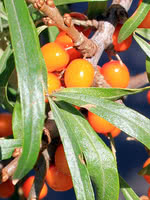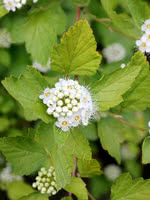Mon-Fri 9am - 5pm Mountain time
Sea Buckthorn (Seaberry) vs Ninebark
Hippophae rhamnoides l.
Physocarpus opulifolius
CUSTOM GROW
Sea Buckthorn, aka Seaberry, is a nitrogen fixing shrub that produces attractive berries high in vitamin C.
While we can't confirm claims that the berries are effective in treating various ailments, many people believe consuming the berries helps with arthritis, infections, and asthma, among other things.
Sea Buckthorn plants have attractive pale silvery-green leaves, dense branches, and large thorns, people like to grow in ornamental hedges or as a first row in a shelterbelt.
Note: these plants typically reach maturity and make their sex easily known (females producing fruit) in their 3rd or 4th year of growth. Our seedlings are too young to identify their sex.
Ninebark is a small, multi-stemmed shrub, that is used to add texture or colour to any yard.
It features flaky, cinnamon-brown bark, attractive white flowers, and long, maple-like leaves.
Sea Buckthorn (Seaberry) Quick Facts
Ninebark Quick Facts
In row spacing: 0.9 - 1.2 m (3 - 4 ft)

